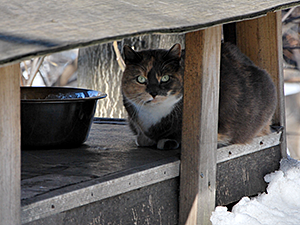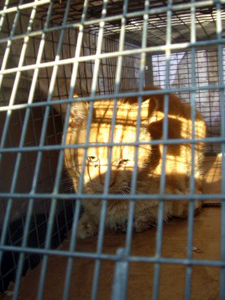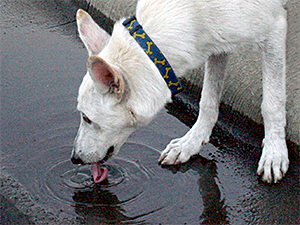
When the temperatures plummet and the streets turn cold and wet, an outdoor cat seeks the warmest shelter it can find. Unfortunately, that sometimes happens to be under the hood of a car next to the engine, or somewhere beneath a car, frequently on top of a tire. In either of these places a cat is well hidden from view and at great risk of injury or worse when a driver starts his or her car.
Not surprisingly, cats will seek out cars that have been recently parked, since their engines are still warm. It is a good idea, though, for all drivers to bang on their car’s hood and wait for a bit to see if a cat has chosen their vehicle as a place to get warm. According to Jane Hoffman, President of the Mayor’s Alliance for NYC’s Animals, “With the current freezing temperatures, we need to be extra vigilant about the welfare of animals living outdoors — especially feral cats, who are forced to find inventive ways to stay warm. Taking 30 seconds to check for cats before starting your engine can mean the difference between life and death.”

To protect the community cats in her care and to try to minimize their attraction to cars in cold weather, The Deputy’s caretaker, a long-time feral cat caretaker, has always provided the cats with winterized shelters. A winterized feral cat shelter is a small, well-insulated structure that is raised off the cold ground. A small shelter will trap a cat’s own body heat and help the cat stay warm. To intensify the warmth, a shelter’s inner walls and floor can be covered in Mylar or another substance that will reflect body heat back to a cat. Straw also retains heat and can be used to line a shelter floor. Caretakers should make sure to use straw and not hay. Straw is hollow and an excellent source of insulation and bedding when stuffed into a winter shelter. Hay is feed and could attract wildlife. According to Mike Phillips of the Mayor’s Alliance’s New York City Feral Cat Initiative and Co-founder of Urban Cat League, a shelter shouldn’t be level and should also have drainage holes in the bottom at the lowest point in order to allow any water that does find its way inside to drain out. Learn more about winter feral cat shelters that you can either make or purchase.
Feeding stations for community cats should also be raised off the ground during the winter to prevent food from freezing. Water should be placed in the sun in thick, deep, plastic containers that will help prevent it from freezing. As an alternative, caretakers might consider investing in solar-heated water bowls, such as the ones made by Solar Sippers.
Even when cats stay clear of car engines, they, and dogs, face another deadly danger in connection with automobiles — antifreeze poisoning. Ethylene glycol, the main ingredient in this liquid used to help keep a car’s engine from freezing, has an aroma and a sweet taste that dogs find appealing. In addition, both cats and dogs can accidentally ingest spilled antifreeze when they lick or drink something on the street or in a home where antifreeze is kept. Antifreeze poisoning can be fatal and should be treated immediately. According to the ASPCA, within 30 minutes of ingesting the liquid, a cat or dog typically appears lethargic, uncoordinated, and disoriented. If left untreated, the symptoms increase to include vomiting, mouth and stomach ulcers, kidney failure, coma, and death.

Pet parents are advised to keep whatever type of antifreeze they do use out of reach of pets and to make sure to clean up any spills right away. In addition, dogs should be restrained from drinking out of puddles on the street. If anyone suspects their pet may have ingested antifreeze they should immediately seek veterinary care or call the ASPCA Animal Poison Control Center at 1-888-426-4435.
Antifreeze is not the only hazard to look out for when walking a dog. The huge amounts of coarse salt spread on city sidewalks to prevent slipping and to help melt ice and snow can irritate the pads on a dog’s paws. Dog booties are now available in a variety of sizes and styles to protect a dog’s feet. If a dog won’t adapt to wearing booties, a pet parent can apply petroleum jelly, olive oil, or Musher’s Secret paw wax to protect the bottoms of their dog’s feet. In addition, after each walk a dog’s paws should be thoroughly cleaned to remove salt and any encrusted ice or snow.
Dogs willing to wear them should have coats or sweaters to help protect them against the cold and windy weather during a walk. Cold air can also dry a pet’s skin, causing it to become itchy or flaky. Pet parents should consider using a humidifier during the coldest months, and should also be aware of drafty and cold places on the floors of their homes and be sure not to position pet beds or food bowls in those areas. Generally, puppies and senior dogs are more sensitive to cold weather than adult dogs are. During the most severely cold days, they should only be taken out for very short amounts of time. Indoors they should have a cozy, warm place to sleep.
 Alert: Stray Voltage Danger!
Alert: Stray Voltage Danger!
One other unfortunate cold weather hazard city pets and their owners face is the potential of shocks from stray voltage. There are thousands of miles of electrical cables right underneath NYC sidewalks. Some of those cables are frayed or defective. If snowmelt and/or salt used to de-ice a sidewalk penetrate down to the cables, there is the risk that a pet or person walking across the sidewalk will receive a shock, which might be strong enough to be fatal. Pet owners are advised to exercise caution and be aware of their surroundings. Avoid manhole covers, sewer caps, metal gratings, Con Edison repair sites, and all overhead scaffolding at constructions sights.
If you suspect your dog is receiving a shock, do not touch your pet or the ground. Instead, immediately make an about face and, using the leash or other non-conductive object, maneuver your pet away from the area. If you travel forward, the voltage might increase. Then call 911 to report the danger.
Even though Staten Island Chuck has seen his shadow, guaranteeing New Yorkers more winter weather, if pet owners and caretakers take some extra precautions, they, and the animals in their care, will soon be enjoying the dog days of summer.

